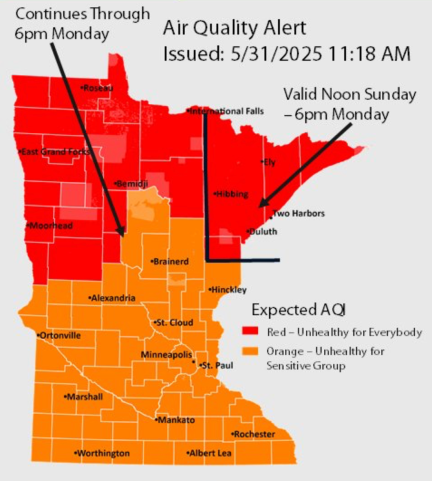
Air quality is expected to reach the red AQI category in northern Minnesota, which is unhealthy for everyone. The rest of the state will reach the orange AQI category, which is unhealthy for sensitive groups.
The Minnesota Pollution Control Agency (MPCA) has issued an air quality alert for all of Minnesota. The alert runs until 6 p.m. on Monday, June 2. The affected area includes all of Minnesota and the Tribal Nations of Upper Sioux, Mille Lacs, Prairie Island, Leech Lake, Red Lake, Grand Portage, and Fond du Lac.
A cold front will continue to drag smoke from large wildfires in Manitoba and Saskatchewan southward into Minnesota. This will be a long-duration event with multiple rounds of smoke expected. The highest concentration of smoke is expected Saturday morning and afternoon. The air quality will improve slightly overnight Saturday before a second wave of smoke arrives Sunday morning. Air quality may improve Sunday evening before a third round of smoke arrives Monday. This air quality alert may need to be extended as additional waves of smoke will be possible.
Fine particle levels are expected to reach the red air quality index (AQI) category, a level considered unhealthy for everyone, across northern Minnesota. This area includes Brainerd, Bemidji, East Grand Forks, Moorhead, International Falls, Two Harbors, Hibbing, Ely, Duluth, Roseau, and the Tribal Nations of Leech Lake, Red Lake, Grand Portage, and Fond du Lac. In the red area, everyone should limit prolonged or heavy exertion and time spent outdoors.
Fine particle levels are expected to reach the orange air quality index (AQI) category, a level considered unhealthy for sensitive groups, across southern Minnesota. This area includes the Twin Cities metro, Alexandria, Albert Lea, Marshall, Worthington, Rochester, Hinckley, St. Cloud, Winona, Ortonville, Mankato and the Tribal Nations of Upper Sioux, Mille Lacs, Prairie Island. In the orange area, sensitive groups should limit prolonged or heavy exertion and time spent outdoors.